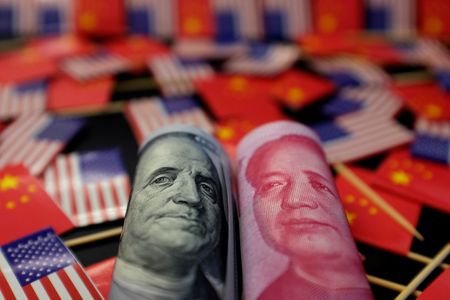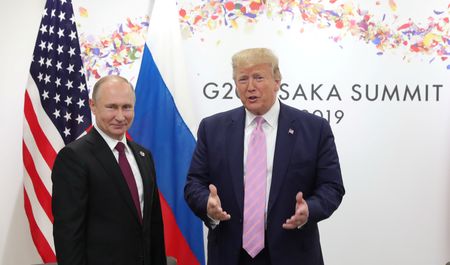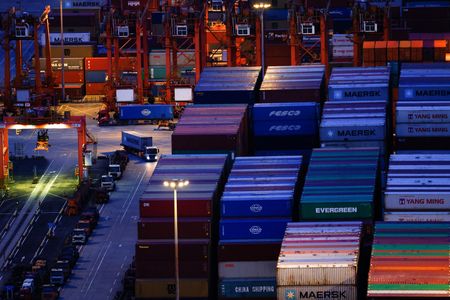By Amanda Cooper, Samuel Shen and Lewis Krauskopf
LONDON/SHANGHAI/NEW YORK (Reuters) -A truce in the U.S.-China trade war set off a relief rally in stocks on Monday and propelled the dollar higher, but investors fear further negotiations could prove a long slog, as risks of a global economic slowdown persist.
After two days of talks with Chinese officials in Geneva, U.S. Treasury Secretary Scott Bessent said the two sides agreed to a 90-day pause under which tariffs would fall by over 100 percentage points.
That leaves U.S. tariffs on Chinese goods at 30% from May 14 to August 12 and Chinese duties on U.S. imports at 10%. The outcome exceeded the hopes of many investors ahead of the talks.
The dollar jumped over 1% against a basket of major currencies, as the yen and Swiss franc fell along with other safe-haven assets like gold and government bonds.
U.S. stocks soared, with the benchmark S&P 500 index ending up 3.3%, while the tech-heavy Nasdaq Composite jumped more than 4%.
U.S. Treasury prices sagged, sending the benchmark 10-year Treasury yield to 4.48%, its highest in about a month, as investors shed safe havens and scooped up risk assets. MSCI’s index of global shares rose over 2%.
The Cboe Volatility index, an options-based measure of investor anxiety, fell below 20 for the first time since late March.
“This is a relief rally that the worst case scenario in tariffs, being tariffs over 100%, is not likely to materialize,” said John Praveen, managing director at Paleo Leon in Princeton, New Jersey. “We may not get zero tariffs but the worst case is unlikely. We’ve pulled back from the brink.”
The cheer was tempered by caution, given a more permanent trade deal needs to be struck, while higher tariffs overall could still weigh on the global economy.
“It’s long-term positive plus 90 days of uncertainty,” said Charles Wang, chairman of Shenzhen Dragon Pacific Capital Management Co.
Michael Metcalfe, head of macro strategy at State Street Global Markets in London, estimated that Monday’s U.S.-China deal implied an average effective tariff rate of around 15%.
“Given where expectations were, it’s a net positive,” he said. “You basically reverse the reciprocal tariff announcement, and if you reverse the reciprocal tariff announcement you are back to square one.”
U.S. President Donald Trump had imposed tariffs of 145% on imports of Chinese goods. China in turn raised tariffs on U.S. goods to 125% and limited exports on some vital rare earth minerals.
Those measures had brought nearly $600 billion in two-way trade to a standstill, disrupting supply chains and sparking fears the global economy could crater.
Trump’s April 2 “Liberation Day” announcement of sweeping tariffs sparked a sharp exit from U.S. assets, including the dollar and Treasuries, mainstays of the global financial system. Heightened uncertainty over U.S. trade policy hurt business and consumer confidence.
“It’s still hard for companies to make decisions on spending,” said Patrick Kaser, portfolio manager at Brandywine Global in Philadelphia. “The market is acting like the risk has gone away, but I don’t think that’s how a lot of businesses and companies are going to view the situation.”
SOFTENING STANCE
Investors saw signs Trump may be rethinking his trade strategy, as economic indicators have weakened and central bankers have warned of risks of slowing growth and rising inflation.
A deal last week with Britain, plus positive noises from Japan, Vietnam and South Korea, helped restore some confidence, as have cooling geopolitical tensions.
“As we’ve seen since the start of April, lower trade uncertainty translates into lower equity market volatility, which in turn eases financial conditions and improves risk sentiment,” said Angelo Kourkafas, senior investment strategist at Edward Jones in St. Louis. “That’s kind of the chain reaction.”
Rabobank’s head of FX strategy Jane Foley said there was more optimism the tariffs will not be as devastating as many had feared, but this did not mean a return to the pre-Trump status quo.
“We still have a fair amount of uncertainty about where these tariffs will settle, their impact on world growth and central bank policy,” she said.
State Street’s Metcalfe said concerns could turn from trade to other issues. For instance, many investors wonder what Trump’s planned tax cuts will mean for U.S. debt levels, especially as revenues from tariffs drop.
The U.S.-China trade deal “doesn’t mean the policy uncertainty has gone away, it’s moved on to a new area,” he said.
The Treasury market’s response appeared at odds with the Trump administration’s goal of bringing down yields on government debt, which provide benchmarks for a wide range of borrowing costs.
“Bessent’s goal of getting long-term rates down is now in tatters,” said Dean Smith, chief strategist at FolioBeyond in New York.
(Reporting by Alun John, Amanda Cooper and Dhara Ranasinghe in London, Samuel Shen in Shanghai, Summer Zhen in Hong Kong, Shashwat Chauhan in Bengaluru and Lewis Krauskopf, Davide Barbuscia and Sinéad Carew in New York; Graphic by Amanda Cooper; Editing by Dhara Ranasinghe, Catherine Evans and David Gregorio)











